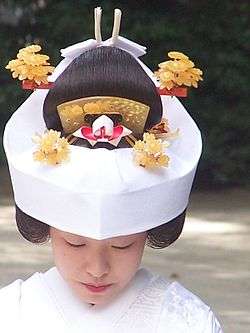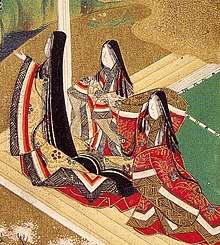Tsunokakushi
Tsunokakushi (角隠し), which means "horn-hiding," is a traditional headgear worn in Shinto wedding ceremonies in Japan.

Japanese bride in her tsunokakushi
Tsunokakushi is a rectangular piece of cloth, which covers the bridal high topknot called Bunkin Takashimada(文金高島田 bunkin takashimada), a kind of Mage(髷 mage), Japanese traditional topknot. It's often made of white silk.
This is traditionally worn to veil the bride's horns of jealousy, ego and selfishness. It also symbolizes the bride's resolve to become a gentle and obedient wife.[1][2]
See also
- Bunkin Takashimada (ja 日本語)
- Mage (ja 日本語)
References
- Buckley, Sandra (2002). Encyclopedia of contemporary Japanese culture. Taylor & Francis. pp. 560–561. ISBN 978-0-415-14344-8.
- Jeremy, Michael; Michael Ernest Robinson (1989). Ceremony and symbolism in the Japanese home. Manchester University Press ND. p. 116. ISBN 978-0-7190-2506-8.
This article is issued from Wikipedia. The text is licensed under Creative Commons - Attribution - Sharealike. Additional terms may apply for the media files.
